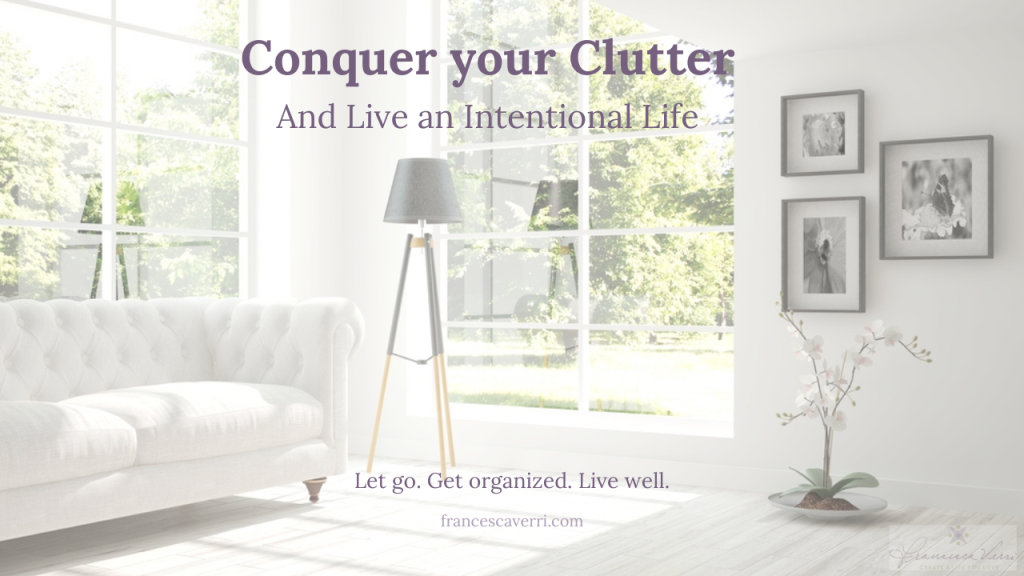The word “declutter” has very negative connotations. And it makes sense why. The word itself means to literally let go of stuff – your stuff. And that act alone can be terrifying.
Painful even.
But there is a way to combat that fear, and arm yourself so you can start the important work of lightening your load. And living your life.
In my many years of working to help people minimize and organize, I can tell you without a shadow of a doubt that knowing where to start with the daunting task of decluttering is key to alleviating fear and creating momentum.
Here are three simple ways to start.
1. Get clear
Clarity is such a buzzword but an important buzzword at that. You see, clarity is king when it comes to accomplishing any project, task, or life endeavor. Simply put, when you are clear on how you want your space to look and feel you will make easier work of letting go and removing from your space the things that pull you from that vision. You will declutter more deliberately. In fact, when you can articulate what a clutter-free space will mean for you, you’ll be more motivated to start the work. And stay the course.
To get clear ask yourself these questions:
How do I want to feel in this space, and how do I want the space itself to feel? And how do I see myself operating in this space? Do you want to feel inspired, prepared, calm? Perhaps you want the space itself to feel systematized, clean, and open. Maybe you want to operate in the space efficiently, and unhurried.
Identify how you want to feel and create a clearer vision in your head of how things can look in your space. {When you start to declutter, that clarity and vision will propel you to let go of what doesn’t fit the vision you seek.}
2. KISS
KISS in this case isn’t keeping it simple. It is keeping it small {although keeping it small is how you simplify what can feel like a complicated endeavor}
Decluttering is daunting enough. If you bite off more than you can chew you will just get indigestion, feel quite overwhelmed, and won’t get started at all. Keeping the scope of the work small is not just a suggestion. It is more of a necessity. To be successful in starting a decluttering project – regardless of the size – you must start small as it can help make the project feel more appealing.
Don’t look at the whole house. Pick a spot like a bedroom, an office, the kitchen. And then break that area down to an even smaller area like a dresser, a desk, a cabinet. Then get started. When you can focus on a smaller part of the whole you keep that overwhelm at bay. And that is an important component of making progress and staying on track.
3. Schedule
You know that saying, “If you fail to plan, you plan to fail”? It applies here. If you want to lighten your load and unclutter your space you must plan to do so. And planning in this way comes in the form of scheduling time to do the work. You may not want to declutter in the scheduled time. You might need to put something seemingly more important in place. But what I know for sure is that when you put it on your calendar you give yourself more of an opportunity to succeed and make progress with decluttering than if you didn’t schedule it in.
You do not need to schedule hours at a time. In fact, to start I recommend you don’t schedule large blocks because that in and of itself can make the project feel too big. Instead, schedule what I call minimal microburst sessions. They are 15-20 minute decluttering sessions in the one, small area in which you are starting. The amount of minimal microburst sessions you schedule a week is up to you. If you are serious about getting uncluttered schedule a session every day – at the same time if possible in order to create a habit.
Remember, there is no rush to the finish line. Any amount of clutter you discard is a necessary step in the right direction and a perfect place to start.
____________________
If you need help to start and do the often daunting work of decluttering, my signature online program Conquer Your Clutter will teach you where to start, how to let go, and how to get organized for good.






[…] remember there is no wrong place to start. The wrong thing to do is to not start at all. Simply start small. When you do this, the how feels more manageable. Letting go – remember that old chestnut? […]